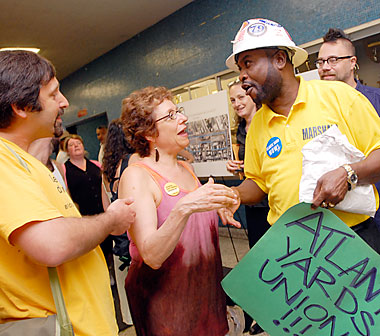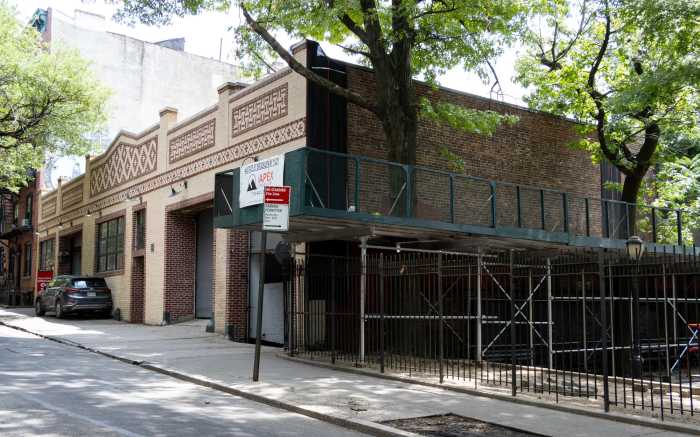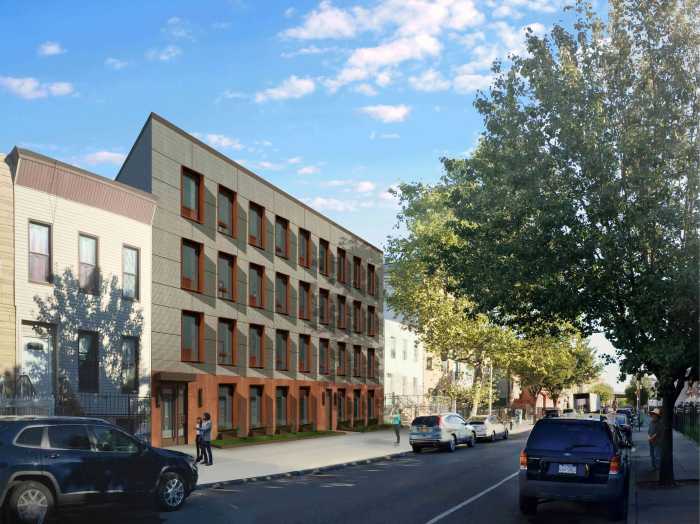Developer Bruce Ratner has yet to birth a building at the Atlantic Yards site, but he’s already causing labor pains.
Unions are recoiling after learning that the mega-developer has been secretly planning a prefabricated tower at the Prospect Heights site — a decision that could significantly jeopardize hundreds of union jobs that Ratner promised to organized labor and their political supporters at a critical juncture in his project’s approval process.
The 34-story building at Flatbush Avenue and Dean Street — the first residential building in what is on paper is stll a $4.9-billion 16-skyscraper project — would be constructed using 900 modules, or prefabricated steel boxes, that would simply be stacked and bolted together, the New York Times reported last week.
This week, union members were the ones bolting — from Ratner.
“This was never part of the plan that was presented to us,” charged Richard Weiss, a spokesman for Construction and General Building Laborers’ Local 79. “If something is going to provide good jobs to our members, we are going to support a project. But, clearly, he’s changed how he is planning to go forward.”
It was the unions who loudly supported Ratner for years, trumpeting the hundreds of construction jobs that were slated to be filled by union workers during the decade it will take to build the project.
If the modular plan proceeds, union jobs would be considerably diminished, as most of the work is completed on a factory floor rather than on site of what would be the world’s tallest prefab building.
“Everything is built in one shot — the electrical, the plumbing — then they pick up the box with a crane and put it in place,” said Tony Buscema, president of the Brooklyn Board of Business Agents, which finds work for the building trade unions. “The building trades don’t get much out of it because the rooms are already completed.”
After the developer’s star-studded groundbreaking, union labor gushed about the project, noting that its peak, it could employ 2,500 construction workers at once.
This week, the Building and Construction Trades Council of Greater New York, an umbrella union, was hardly as effusive.
“We have obvious concerns about the safety and quality of modular construction for larger buildings as well as its impact on estimates for job creation, wages and benefits that have been central to the economic justification for projects advancing,” the group said in a statement.
But what’s bad for labor might be good for the developer.
The modular move could cut Ratner’s construction costs in half, according to the Times, as fewer and cheaper workers could build the structures.
That said, a modular construction approach would allow Ratner to add 400 units of affordable housing units, fulfilling the developer’s promise that 30 percent of the new apartments would be reserved low-to middle-income residents.
Ratner is bound by an agreement with the state to begin excavation by May 2013, or fork over up to $5 million in penalties for every year the project falls behind.
MaryAnne Gilmartin, Forest City’s executive vice president, stressed that the company is considering a conventional building along with the modular option.
“Modular technology is cutting edge, allowing for more sustainable and efficient development,” she said. “Particularly now, this could translate into more middle income, affordable and elderly housing.”
Ratner is already scouting sites in Queens to build a modular factory, according to the Times.
Steamfitters, were, well, steamed.
“I’m not crazy about it,” said Chris Sheeran, the union’s business agent.
And it’s not just about jobs — it’s also about safety, he said. “Things built from the ground up are going to be more sturdy.”
State and city officials agreed to subsidize the project to the tune of $300 million, in part because of its stated benefits: a basketball arena and thousands of union jobs — roughly 1,700 over a 10-year span.
But now, lawmakers are calling on the city to reconsider the $200 million it plans to direct toward the project — considering that modular construction would reduce total wages, and, therefore, tax revenues.
“It has become clear that city is very likely to lose many millions of dollars on this project, even as many of the contemplated benefits have evaporated,” said Councilman Brad Lander (D–Park Slope). “We need a new cost-benefit analysis before we proceed to put city taxpayer money into this project, just as we need real public oversight and accountability.”
The prefab development is the latest in a series of cost cutting moves critics say further tarnishes a project once billed as an architectural jewel.
In 2009, Yards architect Frank Gehry was sent packing and his glitzy, one-of-a-kind arena was “value” redesigned, as financing woes mounted.
In November, Ratner asked the city for an additional $10 million for the first residential tower, blaming a tough lending market.
The federal bribery complaint against state Sen. Carl Kruger also cast an unwanted spotlight on the project. According to prosecutors, Forest City Vice President Bruce Bender negotiated with Kruger for more state money for the project. Bender and Forest City have not been charged with any wrongdoing, though the company did employ lobbyist Richard Lipsky, who was arrested earlier this month with Kruger in connection with bribing public officials — and cops found $104,000 in cash in his home.

























